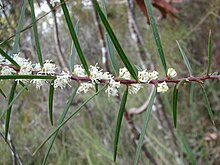Hakea ulicina: Difference between revisions
Tom.Reding (talk | contribs) m →top: Fix Category:CS1 maint: Uses authors parameter: vauthors/veditors or enumerate multiple authors/editors; WP:GenFixes on using AWB |
Rescuing 2 sources and tagging 0 as dead. #IABot (v1.6beta3) |
||
| Line 18: | Line 18: | ||
The species was first formally described by [[Robert Brown (botanist, born 1773)|Robert Brown]] in ''[[Supplementum primum prodromi florae Novae Hollandiae]]'' in 1830, based on plant material collected by [[William Baxter (botanist)|William Baxter]] in [[Wilsons Promontory]].<ref>{{cite web |url=http://www.anbg.gov.au/cgi-bin/apni?TAXON_NAME=HAKEA+ULICINA|title= ''Hakea ulicina''|accessdate=2008-08-31|work= [[Australian Plant Name Index]] (APNI), IBIS database|publisher = Centre for Plant Biodiversity Research, Australian Government, Canberra}}</ref> |
The species was first formally described by [[Robert Brown (botanist, born 1773)|Robert Brown]] in ''[[Supplementum primum prodromi florae Novae Hollandiae]]'' in 1830, based on plant material collected by [[William Baxter (botanist)|William Baxter]] in [[Wilsons Promontory]].<ref>{{cite web |url=http://www.anbg.gov.au/cgi-bin/apni?TAXON_NAME=HAKEA+ULICINA|title= ''Hakea ulicina''|accessdate=2008-08-31|work= [[Australian Plant Name Index]] (APNI), IBIS database|publisher = Centre for Plant Biodiversity Research, Australian Government, Canberra}}</ref> |
||
The species occurs on the southern slopes of the Great Dividing Range as well as in coastal heathland. It is mostly found from the east of [[Port Phillip Bay]] in Victoria through to [[Eden, New South Wales|Eden]] in south-eastern New South Wales. Additional populations occur in the [[Brisbane Ranges]] and [[Anglesea, Victoria|Anglesea]] to the west of Port Phillip Bay, as well as Tasmania's [[Furneaux Group]] of islands.<ref name=Vic>{{cite web|title=''Hakea ulicina'' R.Br.|work=Flora of Victoria Knowledge Base|publisher=Royal Botanic Gardens Melbourne|url=http://www.rbg.vic.gov.au/dbpages/dev/vicflora/index.php/viclist/name/1223|accessdate=4 March 2014}}</ref> A similar species from South Australia and western Victoria, ''[[Hakea repullulans]]'', can be distinguished by its broader leaves and presence of a [[lignotuber]].<ref name=Vic4086>{{cite web|title=''Hakea repullulans'' H.M.Lee |
The species occurs on the southern slopes of the Great Dividing Range as well as in coastal heathland. It is mostly found from the east of [[Port Phillip Bay]] in Victoria through to [[Eden, New South Wales|Eden]] in south-eastern New South Wales. Additional populations occur in the [[Brisbane Ranges]] and [[Anglesea, Victoria|Anglesea]] to the west of Port Phillip Bay, as well as Tasmania's [[Furneaux Group]] of islands.<ref name=Vic>{{cite web|title=''Hakea ulicina'' R.Br.|work=Flora of Victoria Knowledge Base|publisher=Royal Botanic Gardens Melbourne|url=http://www.rbg.vic.gov.au/dbpages/dev/vicflora/index.php/viclist/name/1223|accessdate=4 March 2014|deadurl=yes|archiveurl=https://archive.is/20140304114901/http://www.rbg.vic.gov.au/dbpages/dev/vicflora/index.php/viclist/name/1223|archivedate=4 March 2014|df=}}</ref> A similar species from South Australia and western Victoria, ''[[Hakea repullulans]]'', can be distinguished by its broader leaves and presence of a [[lignotuber]].<ref name=Vic4086>{{cite web|title=''Hakea repullulans'' H.M.Lee|work=Flora of Victoria Knowledge Base|publisher=Royal Botanic Gardens Melbourne|url=http://www.rbg.vic.gov.au/dbpages/dev/vicflora/index.php/viclist/name/4086|accessdate=5 March 2014|deadurl=yes|archiveurl=https://archive.is/20140304233126/http://www.rbg.vic.gov.au/dbpages/dev/vicflora/index.php/viclist/name/4086|archivedate=4 March 2014|df=}}</ref> |
||
http://www.rbg.vic.gov.au/dbpages/dev/vicflora/index.php/viclist/name/4086|accessdate=5 March 2014}}</ref> |
|||
==References== |
==References== |
||
Revision as of 02:44, 28 October 2017
| Furze hakea | |
|---|---|

| |
| Hakea ulicina in Bunyip State Park, Victoria | |
| Scientific classification | |
| Kingdom: | |
| (unranked): | |
| (unranked): | |
| Order: | |
| Family: | |
| Genus: | |
| Species: | H. ulicina
|
| Binomial name | |
| Hakea ulicina | |
Hakea ulicina, commonly known as furze hakea, is a shrub in the family Proteaceae, native to Australia. It is erect in habit, growing to between 2 and 5 metres tall.[1] It has long, narrow leaves which are 3 to 18 cm long and 1 to 4 mm wide.[1] White conflorescences appear in the leaf axils in spring.[2]
The species was first formally described by Robert Brown in Supplementum primum prodromi florae Novae Hollandiae in 1830, based on plant material collected by William Baxter in Wilsons Promontory.[3]
The species occurs on the southern slopes of the Great Dividing Range as well as in coastal heathland. It is mostly found from the east of Port Phillip Bay in Victoria through to Eden in south-eastern New South Wales. Additional populations occur in the Brisbane Ranges and Anglesea to the west of Port Phillip Bay, as well as Tasmania's Furneaux Group of islands.[4] A similar species from South Australia and western Victoria, Hakea repullulans, can be distinguished by its broader leaves and presence of a lignotuber.[5]
References
- ^ a b Corrick, M.G.; Fuhrer, B.A. (2001). Wildflowers of Victoria and adjoining areas. Australia: Bloomings Books. ISBN 1876473142.
- ^ R.M. Barker. "New South Wales Flora Online: Hakea ulicina". Royal Botanic Gardens & Domain Trust, Sydney, Australia.
- ^ "Hakea ulicina". Australian Plant Name Index (APNI), IBIS database. Centre for Plant Biodiversity Research, Australian Government, Canberra. Retrieved 2008-08-31.
- ^ "Hakea ulicina R.Br". Flora of Victoria Knowledge Base. Royal Botanic Gardens Melbourne. Archived from the original on 4 March 2014. Retrieved 4 March 2014.
{{cite web}}: Unknown parameter|deadurl=ignored (|url-status=suggested) (help) - ^ "Hakea repullulans H.M.Lee". Flora of Victoria Knowledge Base. Royal Botanic Gardens Melbourne. Archived from the original on 4 March 2014. Retrieved 5 March 2014.
{{cite web}}: Unknown parameter|deadurl=ignored (|url-status=suggested) (help)
